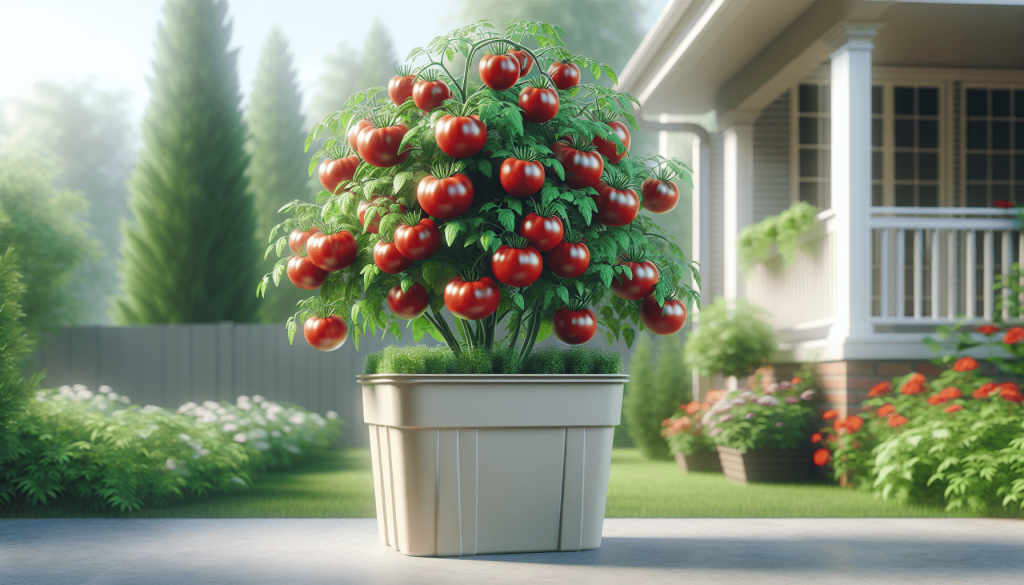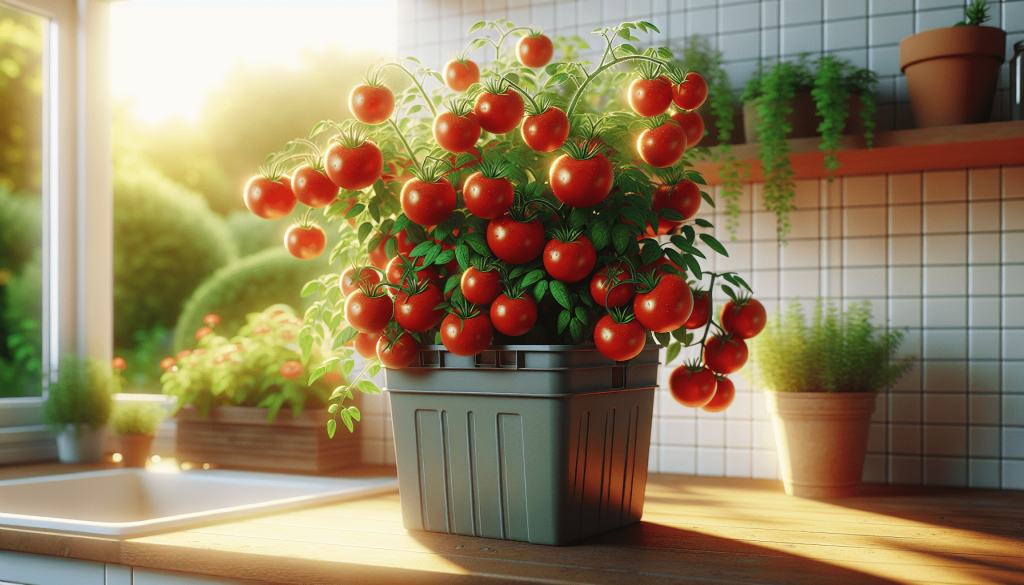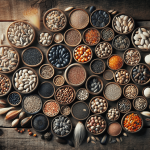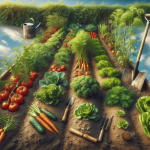This post may contain affiliate links. As an Amazon Associate, we may earn commissions from qualifying purchases.
Ever wondered how you can successfully grow your own tomatoes in containers? It’s a common question that has crossed the minds of many gardening enthusiasts. Tomatoes are one of the most satisfying plants to grow—and they can even thrive in containers if you don’t have a garden space. The process can be incredibly rewarding, and you’ll find that the taste of home-grown tomatoes is far superior to what you buy in the store. You can control every aspect of growth, from the type of soil to the amount of sunlight and water. Let’s embark on this tomato-growing journey together!
Selecting the Right Container
Choosing the right container is the crucial first step. The container must be large enough to support a mature plant, and it should have adequate drainage holes. The material of the container can vary—plastic, terracotta, or fabric planters can all work well.
Container Size
The size of your container will directly impact the health and productivity of your tomato plant. A pot that is too small will restrict root growth and limit the nutrients available to the plant.
| Tomato Variety | Minimum Pot Size |
|---|---|
| Dwarf | 5 Gallons |
| Determinate | 10-15 Gallons |
| Indeterminate | 15-20 Gallons |
Drainage
Drainage is another vital aspect. A container with poor drainage will cause the plant roots to become waterlogged, leading to root rot and other problems. Ensure your container has multiple drainage holes at the bottom. If the container you’ve chosen has no holes, you can easily drill some yourself.
Picking the Perfect Tomato Varieties
All tomato varieties can technically be grown in containers, but some are more suited than others. You’ll want to balance your choice based on the size of the container and your own gardening experience.
Dwarf Varieties
Dwarf varieties are perfect for small containers and are generally easier to manage. These plants typically don’t grow taller than 2-4 feet. Some popular dwarf varieties include:
- Tiny Tim
- Patio Princess
- Balcony
Determinate Varieties
Determinate varieties, often referred to as “bush” tomatoes, grow to a certain height and then stop. They produce fruit all at once, making them perfect for those looking to harvest at one time. These are great for medium-sized containers.
- Roma
- Celebrity
- Bush Early Girl
Indeterminate Varieties
Indeterminate varieties grow and produce fruit continuously throughout the season. These can get quite large, so they need very large containers and sturdy support. If you have the space and are up for the challenge, here are some favorite indeterminate varieties:
- Big Boy
- Cherry Tomatoes
- Beefsteak

The Ideal Soil Mix
Your tomato plants need a rich, nutrient-filled environment to thrive. Garden soil alone won’t do the trick because it’s often too compact.
Soil Composition
A good soil mix for container gardening contains equal parts of garden soil, compost, and perlite or vermiculite. Compost adds essential nutrients, while perlite or vermiculite improves soil aeration and drainage.
| Ingredient | Function |
|---|---|
| Garden Soil | Base for the mix |
| Compost | Provides nutrients |
| Perlite/Vermiculite | Improves aeration & drainage |
Avoid Using Plain Garden Soil
Using plain garden soil in your containers isn’t advisable. It can become compacted and restrict air and water flow to the roots, ultimately hampering the plant’s growth. Instead, opt for a high-quality commercial potting mix or make your own as described above.
Planting Your Tomatoes
Getting your tomato plant into its new home properly is critical for its development. The steps are quite straightforward, but each one is vital for giving your plant the best start.
Preparation
Before planting, water your tomato plant thoroughly. This helps to reduce transplant shock. Also, make sure your container is filled nearly to the top with your prepared soil mix.
Planting Steps
- Dig a Hole: Dig a deep hole in the center of your container. Tomatoes can be planted deeper than other plants because they develop roots along their stems.
- Remove Lower Leaves: Pinch off the lower set of leaves from the tomato plant.
- Place in Hole: Gently place the tomato plant in the hole, filling in soil around the stem up to the remaining set of leaves.
- Water Thoroughly: Give your plant a good drink to help settle the soil and eliminate air pockets.

Providing Essential Support
Tomatoes are notorious for becoming heavy and unwieldy as they grow, which calls for some solid support systems.
Stakes and Cages
Stakes and cages help guide the growth of the plant and keep the fruit off the ground where it could rot or suffer from pests.
- Stakes: Made of wood, bamboo, or metal, stakes are driven into the soil near the plant and tied to the stem with soft ties.
- Cages: Tomato cages are wire frames placed over the plant. They are fantastic for indeterminate varieties that can grow quite tall.
Trellises
For those planting indeterminate varieties in larger containers, trellises can be a fantastic option. They allow the plant to climb, maximizing the use of vertical space.
| Support Type | Suitable For | Installation |
|---|---|---|
| Stakes | Dwarf/Determinate | Simple, just stake and tie |
| Cages | Indeterminate | Place over plant early |
| Trellises | Indeterminate | Attach vines as they grow |
Watering Strategies
Proper watering is one of the most critical aspects of tomato container gardening. Too little or too much water can both be detrimental.
Consistent Moisture
Tomatoes need consistent moisture levels. The soil should be damp but not waterlogged. Generally, watering once a day or every other day should suffice, but this can vary based on climate and container size.
Watering Techniques
- Water at the base: Always water at the base of the plant to avoid wetting the foliage, which can lead to fungal issues.
- Use mulch: Adding a layer of mulch on top of the soil can help retain moisture and prevent the soil from drying out.
Signs of Over or Under-Watering
Being attuned to signs of over or under-watering will help you adjust your approach.
- Over-watering: Yellowing leaves and a moldy appearance on the surface of the soil.
- Under-watering: Wilting leaves and dry soil.
Fertilizing Your Tomatoes
Tomatoes are heavy feeders and will benefit from regular fertilization. Choosing the right fertilizer and knowing how and when to apply it can make a world of difference.
Types of Fertilizers
- Balanced Fertilizer: A balanced fertilizer (10-10-10) provides equal parts of nitrogen, phosphorus, and potassium.
- Tomato-Specific Fertilizers: These are specifically formulated to meet the nutritional needs of tomato plants, often with a higher ratio of phosphorus (the middle number).
Application Frequency
You should start fertilizing when you plant your tomato and continue every two weeks for best results. Always follow the instructions on the fertilizer package to avoid over-fertilization, which can burn the plant’s roots.
| Fertilizer Type | N-P-K Ratio | Application Frequency |
|---|---|---|
| Balanced Fertilizer | 10-10-10 | Every 2 weeks |
| Tomato-Specific | 5-10-10 | Every 2 weeks |
Pest and Disease Management
Tomatoes in containers can still fall prey to pests and diseases, even though they are less likely to do so than tomatoes grown in the ground.
Common Pests
- Aphids: These tiny, sap-sucking insects can be a nuisance. Insecticidal soap or a strong spray of water can keep them at bay.
- Tomato Hornworm: These large green caterpillars can decimate a plant quickly. Hand-picking is often the best method of control.
Diseases
- Blight: Early and late blight are common fungal diseases. Good air circulation, avoiding wetting the leaves, and using copper-based fungicides can help prevent this.
- Root Rot: Prevented by ensuring good drainage and not over-watering the plant.
Pruning for a Better Harvest
Pruning might seem like an advanced technique, but it’s quite manageable once you get the hang of it. Pruning can improve air circulation and sunlight penetration, leading to a healthier plant.
When and How to Prune
Start pruning when the plant is young. Remove the lower leaves and any ‘suckers’ that grow in the joint between the stem and a branch. This focuses the plant’s energy on producing fruit rather than more foliage.
Benefits of Pruning
Pruning helps reduce the risk of disease and can lead to a more fruitful harvest. It’s especially beneficial for indeterminate varieties, which can otherwise become very bushy and unmanageable.
Harvesting Your Tomatoes
Finally, the moment you’ve been waiting for—harvesting your tomatoes! Timing is crucial for the best flavor and texture.
Knowing When to Harvest
Tomatoes should be harvested when they are fully colored and slightly firm to the touch. Depending on the variety, this can range from bright red to yellow or even purple.
Harvesting Tips
- Use scissors or pruning shears: This helps avoid damaging the plant.
- Check daily: During peak production, check your plants daily to ensure you’re picking at the optimal time.
Troubleshooting Common Problems
Even with the best care, sometimes things don’t go as planned. Knowing how to troubleshoot common issues can save your crop.
Yellow Leaves
Yellowing leaves can indicate several issues—from under-watering to nutrient deficiencies. Check your watering practices first, then consider a balanced fertilizer if watering isn’t the problem.
Blossom End Rot
This common tomato issue appears as a dark, sunken spot on the bottom of the fruit. It’s usually a result of calcium deficiency and inconsistent watering. Adding crushed eggshells to the soil can help, as can consistent watering practices.
Cracked Fruits
Cracked fruits usually indicate uneven watering. Ensure your plants get a consistent amount of water, even if it means watering more frequently in hot weather.
Enjoying Your Bounty
After all the nurturing and care, it’s time to enjoy the fruits of your labor! Tomatoes fresh from the vine can be used in a myriad of ways—from a simple Caprese salad to a hearty tomato soup. And the taste? Simply unbeatable.
Growing tomatoes in containers is not just feasible; it’s immensely rewarding. With the right preparation, care, and a bit of patience, you’ll be harvesting delicious, home-grown tomatoes in no time. Now, roll up your sleeves and get planting—you’re about to discover just how delightful and productive container gardening can be.








